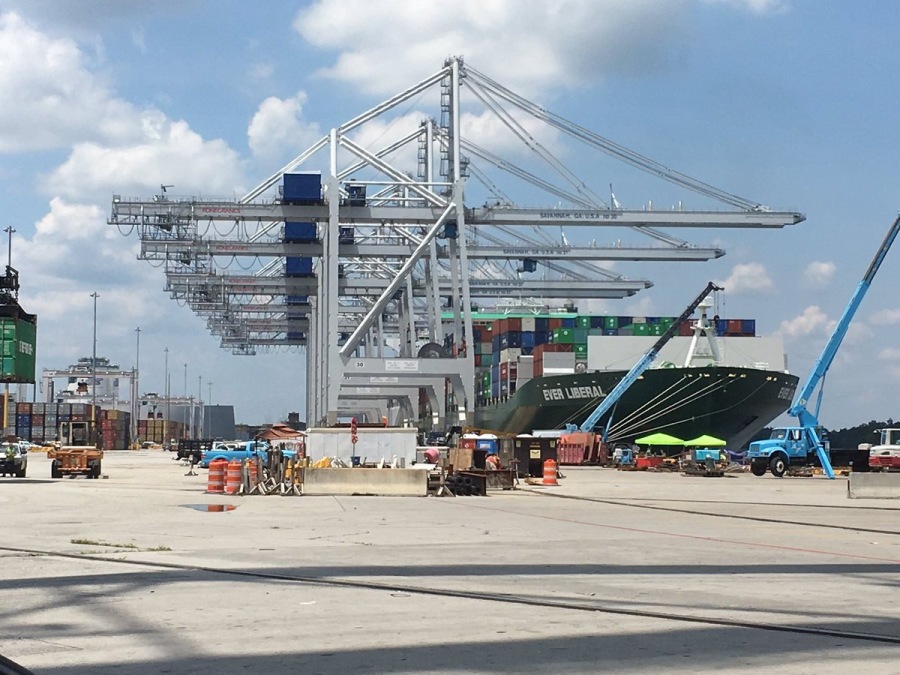DEVELOPING A SENSE OF URGENCY, by BILL STANKIEWICZ, SUPPLY CHAIN EXECUTIVE, PORTFRESH LOGISTICS

One of the keys in running a successful company is to have a sense of urgency, being able to scale with technology & keep staff motivated. I will tell a story & give insights to JCB who is one company that is able to accomplish what I have mentioned.
I want to talk a little about JCB & share some history for all of our folks here. I know many of their senior managers out of the UK & they were started by the Bamford Family who still control the direction & operations of the company. I have done a lot of work with imports & exports of oversize out of gauge freight & how to ship items like JCB products as an example. I Savannah I teach the Pilot Escort program for OS/OOG Freight & its exciting to work on projects. But lets tell you more about how back hoes started below.
HPS (Hydraulic Plant Services) is a well-established JCB parts supplier, JCB spares supplier and Terex parts supplier which can source all JCB spares, JCB spare parts, Terex spares and Terex parts to a JCB dealer or Terex dealer. HPS also supplies JCB 3CX parts, JCB digger parts, JCB replacement parts and JCB backhoe parts.
History of Backhoes
A British company called JCB developed the earliest backhoes. The first vehicle equipped with both a front mounted bucket and a backhoe was completed for the first time in 1953. In early 1957, a small American based firm in Indiana developed a hydraulic powered backhoe which was acquired by JCB. Around 1949 American Tractor which had been making crawlers since 1949 developed numerous innovations which are used today. Elton Long (an engineer) brought a team together to finish making an integrated loader/backhoe which was successfully completed. It was not until 1971 that the first ‘over center’ backhoe was introduced and it offered a much smoother ride and better maneuverability than older models. In 1988 Fortune magazine named the Case loader/backhoe one of the top 100 best products that were made in the United States.
Today, backhoes are manufactured by a number of manufacturers including Volvo Construction Equipment, Komatsu, Caterpillar, Deere & Company, Ford Motor Company and others. In Europe, backhoes are still commonly called JCB’s and the term ‘backhoe’ is rarely familiar to residents.
It is critical that you understand the background of how the backhoe came to be. Millions of housing starts between 1945 and 1955 (for soldiers returning from the war) created a need for more efficient construction equipment. “Conditions demanded a compact machine that could work fast and perform multiple jobs,” said Rusty Schaefer, marketing manager at Case Construction Equipment. “With construction activity at a record pace and demand for equipment high, the time was right for an integrated, multi-function machine.” We had never seen such a demand for construction – from standard residential construction, luxury homes and even commercial construction. More and more often, contractors were interested in saving time and being more efficient.
This was also a time when contractors were trying all types of schemes to get their equipment to work more efficiently, often resulting in a late realization that tractors were simply not designed to accommodate the attachments to add front end loaders and backhoes onto them. While these piecemeal products were more efficient than men with shovels were, they simply lacked the technology to be truly efficient.
In spring of 1957, we finally had a fully integrated backhoe/loader which was made by the Case Company. Not only was this machine compact, but it also was easy to maneuver, could handle small jobs that had previously been done by a team of men by hand, it had rubber tires offering it mobility and in addition, it could work in smaller areas and even areas that had some obstructions. As an added bonus, this unit also offered pallet forks and crane booms further enhancing its usability.
As demand for more improved products were heard, Long and Case responded to these demands and continued to make improvements eventually offering backhoe buckets that were up to 38”, self leveling buckets and even later a swing mechanism. Of course many times today we see the ‘over center’ – not only do these offer additional stability but they also improve the handling and ‘ride’ of the backhoe.
It was 1959 before the first diesel powered unit was available, 1963 before a unit including a power loader and hydraulic cushions, 1966 brought on a ‘return to dig’ feature and finally in 1967 an extendable backhoe was introduced.
Even today, Case maintains open lines of communication with the users of these machines and they have resulted in many additional features including high-visibility cabs, precision bucket placement and hydraulic coupler systems.
The Use of Backhoes
The backhoe loader is perhaps one of the most readily identified pieces of equipment as we see them everywhere – but most people simply call them backhoes! These units are so adaptable and are actually three pieces of important equipment all rolled into one machine, typically a tractor, a loader and a backhoe all in one. A tractor of course is familiar to all of us all by itself. Tractors easily get maneuver around rough terrain, it has basic driving controls such as a steering wheel and brakes and it generally has very large tires and a diesel engine. The cabs are either canopy style or completely enclosed which offers the operator protection from flying debris and the elements. The loader is attached to the front of the tractor, and can be thought of as a huge dustpan as its use is mainly to carry debris that is picked up from the ground. It may also serve as a way to smooth over piles of dirt or debris using its large, flat front. The backhoe of course is the most functional of the three units, attached to the rear of the tractor. With the backhoe, you can dig up compact material, lift heavy materials and literally drop materials anywhere you desire. A backhoe basically has three pieces – a boom, a stick and a bucket – each functioning in synchronization with the others. The boom is bent upwards to make digging around obstacles easy and provides additional space for the bucket which has a full load. Drivers of backhoes will park the tractor, turn the seating unit around and this is how the backhoe digs holes efficiently.
Nearly all backhoes have stabilizer legs. These are found behind the back wheels of a backhoe and are critical to the proper operation of a backhoe since they hold the major amount of weight when a backhoe is actually digging. Stabilizer legs insure that the weight of a heavy load coupled the pressure of digging prevent the tractor from bouncing. In addition, they prevent the tractor from falling into the ditch or hole that it’s digging! The stabilizer legs have shoes – one for asphalt (rubber padded shoes) and one for dirt (grouser shoe).
Popularity of Backhoe Loaders
Since backhoe loaders are easily driven on a road, can be easily maneuvered around sites and are able to both dig and load, bypassing the need to have two pieces of equipment to do these jobs, backhoes have risen in popularity over the last decade. Caterpillar alone has sold more than 100,000 units since 1985. Backhoes are far more compact in comparison to excavators, they easily move around a variety of sites, and while mini-loaders and backhoes as single units are smaller than most backhoe loaders, the fact remains that a single piece of equipment is easier to contend with than multiple pieces. Let’s not forget that the majority of projects require both digging and moving – projects such as laying cable lines, digging for new pipes or even setting up the foundation for buildings. Because the backhoe loader can do all of these tasks, it is often used versus the more efficient single tools that are capable of this work.
Hydraulics
The hydraulic system is a source of amazement for many. Let’s face it, pumping liquid into a system and using it to lift anything seems to be an impossible undertaking. When you combine the enormous strength needed to lift the loads that backhoe loaders are undertaking, how could you possible think it would work! Simply put hydraulics send forces from point to point through the use of fluid. While a lot of systems will use fluid that can’t be compressed (such as oil), with a hydraulic machine, the oil from one piston pushes another piston (which has a larger diameter) and causes it to extend. In some backhoe loaders, the hydraulic system is capable of forcing upwards of 3300 pounds per inch into the cylinder (which has a diameter of about 5”) and gives that piston a thrust that is equal to 70,000 pounds of force! Of course, there has to be a valve system in place to maintain constant pressure. This pressure is generated from an oil pump that is powered by the engine and applies force to the oil which generates the pressure. All of this is accomplished when the backhoe operator uses the controls (typically joysticks) which control the valves. Depending on the model, the controls may be operated with pistons that can control the movement of the valves. It’s notable that the valve system is designed to move the pistons in two directions and that each piston is controlled by it’s own valve resulting in controlling four ‘spools’ when digging with a backhoe.
One of the variables in backhoes is how deep they’ll allow digging. Generally backhoes dig somewhere between twelve and sixteen feet and have extendable arms that let them increase the depth as needed. The horsepower rating is a measure of how much work the backhoe can provide (measuring power) – those with more horsepower offer greater dig depth. Another important factor is the breakout force rating which outlines the force the arm of the backhoe applies when it is working a load. This is measured typically by how hard the end of the bucket pushes, but the hydraulics will have an effect on this. With the stick, lift and boom ratings, a contractor can determine the maximum weight that can be lifted as well as the general capacity that the backhoe will handle.
The loader will also have its own set of hydraulics which work slightly differently as they work in two’s. Whether it’s a single tilt or a parallel lift, each uses a piston to lift the loader arms which are attached to the tractor and hold the bucket. Single tilt loaders use one central ram while parallel lifts use a second pair which is typically attached to the arms and the bucket as well. To stabilize the bucket as it’s lifted, parallel lift loaders use an eight bar linkage system which prevents it from dumping materials as the bucket is lifted up from the ground.
Backhoe loaders are equipped with ride control allowing a full load to be carried without causing the entire tractor to sway while driving. This is done by the use of a shock absorber system which is also hydraulic. Similar to the arms of backhoes, loaders are also rated by breakout force which will define the force that the rams can apply to the bucket which will clarify how the loader is able to push or lift a load.
Only one needed
It’s incredible when you think of the complexity of the backhoe loader that you could possibly need only one person to operate all of the controls that are inherent to this system. After all, the arm swivels on four (or five) hinges, the loader moves on two (or three) and the operator needs to also control the arms, move the tractor and do the loading all at the same time! Backhoe loaders operate with joysticks and each one has a different function. The right handed one scoops the bucket and if you push it to the right side, it will dump the bucket; pushing the left joystick to the left swings the backhoe to the left and if pushed to the right swings the arm to the right, pulling the joystick toward you moves it closer to you and pushing it away from you pushes the boom away from you and finally the joystick on the left moves the boom and swings the backhoe from left to right.
Learning to dig with a backhoe requires training, practice and patience. As with most experienced automobile or truck drivers, backhoe operators get to a point where they simply allow the controls to become second nature to them and they understand which positions allow for the best efficiency. The loader of course is much less complicated as the only functions it performs are raising, lowering and dumping. This requires only one control and it is always to the right of the operator – pull it toward you and the arms lift and push it away and the arms lower, scoop by moving the joystick left and dump by moving the joystick right – it’s far less complicated than learning how to use the backhoe! You could compare the loader with the operation of a shovel or a wheelbarrow that you’d use at home! You know how to use them to get the most of their operation – and backhoe loader operators know exactly what they need to do to perform at peak efficiency.
For help of support feel free to call me or email me, here to help. Email: info@savannahsupplychain.com
Best regards,
Bill Stankiewicz
Savannah Supply Chain Guy
PHONE: 1.404.750.3200
"Articles from Bill Stankiewicz
View blog
SAVANNAH, Ga., August 12, 2019 · - · Intermodal cargo continues its powerful rise at the Georgia Por ...

An MIT study done in April, showed that around 50% of the population was working from home in April. ...

GAINESVILLE, Ga., Dec. 3, 2018 - Gov. Nathan Deal, along with representatives of the Georgia Ports A ...
Related professionals
You may be interested in these jobs
-

CT Technologist
Found in: beBee S2 US - 4 weeks ago
PHP Arcata, United States Full time, Freelance· Position: Travel CT Technologist - $3,231 per week · PHP is seeking a travel CT Technologist for a travel job in Arcata, California. · Job Description & Requirements · Specialty: CT Technologist · Discipline: · Allied Health Professional · Start Date: · 03/12/2024 · Duration: ...
-

Crew Member
Found in: beBee S2 US - 3 weeks ago
sonic, Sonic Alvarado, United States Full timeAs a SONIC Drive-In Crew Member – which may include Frozen, Fountain, Expo, or Switchboard – your primary responsibility is to provide every guest with a SuperSONIC experience by: · • Creating and packaging delicious menu items · • Trying to beat your best record, every time · • ...
-
Burger King Cashier II
Found in: Lensa US P 2 C2 - 3 days ago
Travel America / Petro - TA Operating, LLC Brunswick, United StatesTheres never been a better time to join Travel. Centers of America For more than 50 years, millions of professional truck drivers and motorists have called our travel centers home, depending on us daily for fuel, food, truck maintenance and essenti Cashier, Customer Service, Trav ...


Comments
Bill Stankiewicz
7 years ago #15
Bill Stankiewicz
7 years ago #14
Bill Stankiewicz
7 years ago #13
Bill Stankiewicz
7 years ago #12
Bill Stankiewicz
7 years ago #11
David B. Grinberg
7 years ago #10
Bill Stankiewicz
7 years ago #9
Bill Stankiewicz
7 years ago #8
Gert Scholtz
7 years ago #7
Bill Stankiewicz
7 years ago #6
Phil Friedman
7 years ago #5
Devesh 🐝 Bhatt
7 years ago #4
Thank You. I wish the same to you.
Bill Stankiewicz
7 years ago #3
Bill Stankiewicz
7 years ago #2
Devesh 🐝 Bhatt
7 years ago #1